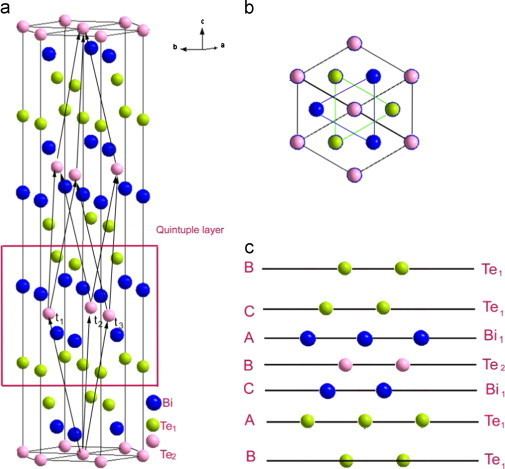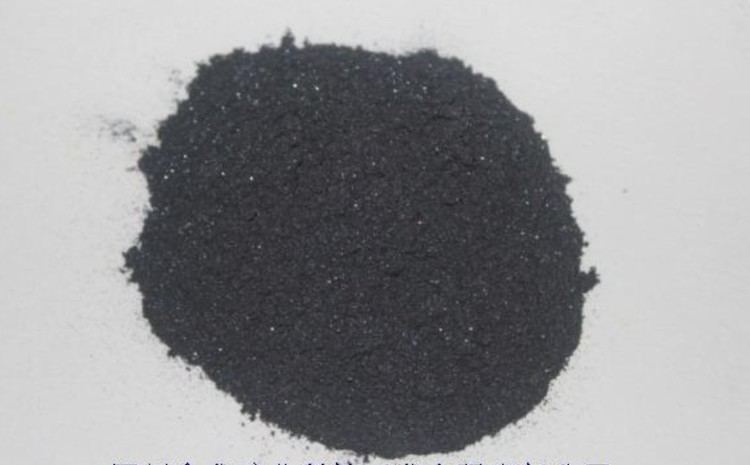Appearance grey powder Density 7.7 g/cm³ | Formula Bi2Te3 Molar mass 800.761 g/mol | |
 | ||
Bismuth telluride (Bi2Te3) is a gray powder that is a compound of bismuth and tellurium also known as bismuth(III) telluride. It is a semiconductor which, when alloyed with antimony or selenium is an efficient thermoelectric material for refrigeration or portable power generation. Bi2Te3 is also known to be a topological insulator, and thus exhibits many thickness-dependent physical properties.
Contents
- Properties as a thermoelectric material
- Properties as a topological insulator
- Occurrence
- Preparation
- References

Properties as a thermoelectric material

Bismuth telluride is a narrow gap layered semiconductor with a trigonal unit cell. The valence and conduction band structure can be described as a many-ellipsoidal model with 6 constant-energy ellipsoids that are centered on the reflection planes. Bi2Te3 cleaves easily along the trigonal axis due to Van der Waals bonding between neighboring tellurium atoms. Due to this, bismuth telluride based materials used for power generation or cooling applications must be polycrystalline. Furthermore, the Seebeck coefficient of bulk Bi2Te3 becomes compensated around room temperature, forcing the materials used in power generation devices to be an alloy of bismuth, antimony, tellurium, and selenium.

Recently, researchers have attempted to improve the efficiency of Bi2Te3 based materials by creating structures where one or more dimensions are reduced, such as nanowires or thin films. In one such instance n-type bismuth telluride was shown to have an improved Seebeck coefficient (voltage per unit temperature difference) of −287 μV/K at 54 Celsius, However, one must realize that Seebeck Coefficient and electrical conductivity have a tradeoff; a higher Seebeck coefficient results in decreased carrier concentration and decreased electrical conductivity.
In another case, researchers report that bismuth telluride has high electrical conductivity of 1.1×105 S·m/m2 with its very low lattice thermal conductivity of 1.20 W/(m·K), similar to ordinary glass.
Properties as a topological insulator
In addition to its role as a thermoelectric material, bismuth telluride is also one of the most commonly studied topological insulators (TIs) to date. Much of this research is focused on its behavior at highly reduced (quasi-2D) thicknesses, since its physical properties have been shown to change as the insulating bulk is reduced and eliminated, leaving only conducting surface states. These thin samples are obtained through either epitaxy or mechanical exfoliation.
Epitaxial growth methods such as molecular beam epitaxy and metal organic chemical vapor deposition are common methods of obtaining thin Bi2Te3 samples. The stoichiometry of the samples obtained through such techniques can vary greatly between experiments. As such, Raman spectroscopy is often used in conjunction with epitaxial growth in order to confirm their relative purities. However, Raman can be difficult to perform on thin Bi2Te3 samples due to its low melting point and poor heat dispersion; anything over 0.5 mW causes localized melting and holes in the sample.
The aforementioned crystalline structure of Bi2Te3 allows for mechanical exfoliation of thin samples by cleaving along the trigonal axis with the use of relatively little force. This process, while significantly lower in yield than epitaxial growth, produces purer samples, as there is no opportunity to introduce defects or impurities. The procedure for this has largely been the same as that used to obtain graphene from bulk graphite samples; applying and removing adhesive tape to remove successively thinner samples. This procedure has been used to obtain Bi2Te3 flakes with a thickness of 1 nm. However, this process can leave significant amounts of adhesive residue on a standard Si/SiO2 substrate, which in turn obscure atomic force microscopy measurements and inhibit the placement of contacts on the substrate for purposes of testing. The use of oxygen plasma as a cleaning agent, an established procedure for use with other graphene-inspired methods, is inviable for use with bismuth telluride; it oxidizes the sample, resulting in fractures as well as a rough, uneven surface. Less damaging cleaning techniques, namely the use of boiling acetone and isopropyl alcohol, have been shown to be ineffective in removing residue.
Occurrence
The mineral form of Bi2Te3 is tellurobismuthite which is moderately rare. There are many natural bismuth tellurides of different stoichiometry, as well as compounds of the Bi-Te-S-(Se) system, like Bi2Te2S (tetradymite).
Preparation
Bismuth telluride is prepared by sealing a sample of bismuth and tellurium metal in a quartz tube under vacuum (critical, as an unsealed or leaking sample may explode in a furnace) and heating it to 800 °C in a muffle furnace.
